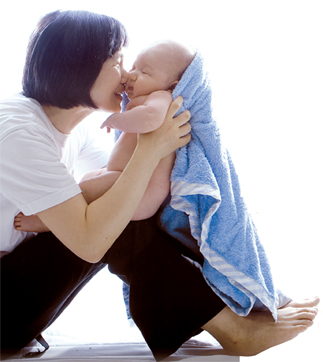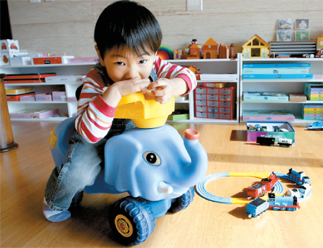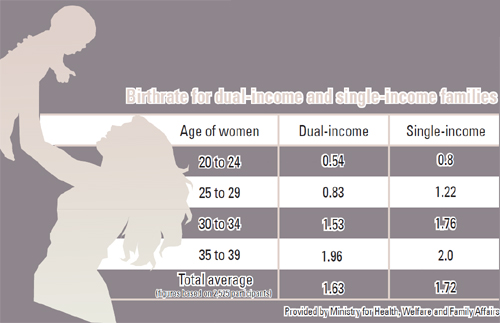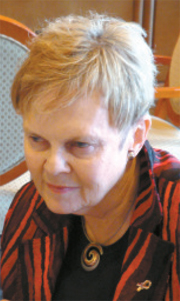What’s behind the baby bust? Ask bourgeois

Jin Sun-ah, who is 41, holds her infant son, Kim Hyun-woo. An increasing number of women like Jin are delaying childbirth until they’re older. Others are limiting the number of children they have or opting not to conceive at all. [JoongAng Ilbo]
The center, however, often feels eerily empty, as it was built to accommodate a much larger number of little ones.
It’s an interesting dynamic. Little Sun, after all, is located near an apartment complex consisting primarily of middle-class and well-to-do residents, a segment of the population that in other countries typically pumps out plenty of children. But the scene in this area is emblematic of a larger trend playing out across the country, one that has become a major issue for Korea going forward.
Government officials are grappling with what to do about the country’s low birthrate, unveiling a host of new measures yesterday meant to help prop up the country’s population. If those efforts fail and the trend continues, however, there could be major repercussions for future generations. A continuation of the low birthrate would ripple through all aspects of life, eroding support for older generations, stifling economic growth and likely leading to the closure of many schools and other community organizations.

Suwon resident Ji Dong-kyu’s 4-year-old son, Sung-jae, takes a break from playtime to pose for the camera. Due to the high costs of raising children in Korea, Ji has decided not to have a second child. By Ahn Sung-sik
“In most cases, birthrates rise with an increase in income,” said Lee Sam-sik, a researcher at the Korea Institute for Health and Social Affairs. “The increased income means more can be invested in raising children, and this usually means an increase in the birthrate. But in Korea, the numbers show a sharp decrease among middle-class families.”
Paltry average
The apartment complex near Little Sun provides a window into the country’s low birthrate.
Households in the complex consisting of married women between the ages of 30 and 35 have an average of just 1.44 children, according to a survey of residents conducted by the Gangnam District Office. Six out of the 100 questioned didn’t have any kids at all.
“It’s very rare for a family in this area to have three children, as most just have a single child or two,” said Kim Hyun-jeong, an instructor at Little Sun Day Care Center. “Compared to other neighborhoods, the number of children per household is fairly low here, and it means day care centers suffer as a result.”
In contrast, another apartment complex not too far away that has more families in the low-income bracket averages about 1.77 children per household, according to the Gangnam District Office.
In Korea, the high-income segment of society produces the most children per household, followed by low-income families and then the middle class. According to a recent study of 5,000 married women between the ages of 20 to 44 conducted by the Ministry for Health, Welfare and Family Affairs, the average monthly income per household among those who participated was 3.3 million won ($2,867). The low-income families that make 1.98 million won or less a month boasted 1.63 children per household. Those in the bottom part of the middle class, who make 1.99 million to 3.29 million won a month, averaged 1.68.
Yet the heart of the middle class, defined as those with 3.3 million to 4.61 million won in monthly income, averaged 1.58 children per household. In contrast, the upper class, which netted an average of 4.62 million won per month or higher, came in at 1.71 children per household.
“The current phenomenon of a low birthrate among the middle class is similar to the situation in Greece, Spain and Italy,” Lee, the researcher, said.
More working women, high education costs
Talk to younger middle-class couples, and the reasons they give for waiting to have children or limiting the number of kids they conceive are often the same.
Ji Dong-kyu, a department chief at the National Pension Service who has a 4-year-old son, said he doesn’t plan on having another child because of exorbitant educational costs and a lack of trustworthy child care centers for babies.

The low birthrate among the middle class is tied to the fact that more women are pursuing careers in the professional world rather than just staying at home and raising kids. These women often find it hard to juggle a job and a family, and they aren’t exactly ready to send children off to day care centers while they work.
So, many families are waiting longer to have children - or deciding not to have any at all.
According to a recent Ministry of Health study on 2,525 married women between the ages of 20 and 39, dual-income households had an average of 1.63 children, while single-income households had a higher average of 1.72. Additionally, ensuring that a child gets into a good college is now an expensive proposition, as families typically must spend gobs of money on additional private classes.
Reversing the trend
The current situation is an about-face from just a decade ago. The government encouraged abortion between the early 1960s and mid-1990s to try to control what at the time was a relatively high birthrate.
Today, the Korean government has to resort to a birth promotion policy to encourage women to have more children.
It’s now scrambling to come up with additional measures on this end. Yesterday, the Presidential Council for Future and Vision announced its plans to deal with the low birthrate, detailing its intention to take a harsh stance on abortion, which is technically illegal but occurs throughout the country. The government, among other moves, will look to aggressively enforce the current law, which stipulates that both doctors who perform abortions and women who have them can receive up to two years in prison. Abortion is only deemed legal if the mother’s life is in danger, if women have been sexually assaulted or if they have genetically based mental or infectious illnesses.
Ministry of Health data reveal that only 4 percent of abortions carried out last year fall under those categories. In fact, an average of 450,000 babies are born in Korea on an annual basis, while 350,000 abortions are carried out, according to ministry data.
Focusing on the middle
To date, most of the government’s support programs and benefits for childbirth - such as a monthly allowance for raising kids - have been geared toward low-income families. Middle-class families can only receive support fees up to three times, and the total amount per instance is limited to 1.5 million won. Such restrictions have lowered the number of families who received support by 31 percent since 2006. The dip stems from an increase in dual-income families who exceeded the monthly income limit.
Lee Yoon-shin, a 31-year-old office worker, falls into this category. She gave birth to a son two months ago and is currently on maternity leave. Lee and her husband had difficulty conceiving, and they tried artificial insemination and other methods. It cost the couple over 10 million won, yet they did not receive any support from the government - something that would discourage many couples from even trying.
“Each time we barely cleared the minimum limit and hence were not eligible for financial support,” Lee said. “I think the middle class has been placed in a dead zone.”
Country can look to France, Israel
Head of Planned Parenthood organization says government must offer plenty of support
Gill Greer, the director general of the International Planned Parenthood Federation, was in Korea recently to encourage relevant bodies here to join her organization’s medical service program in developing countries.

Gill Greer
In order to reverse Korea’s critically low birthrate, Greer - who spoke before the government unveiled new measures yesterday to combat the problem - pointed to France. The French government provides plenty of nursery and day care centers. Both mothers and fathers are also eligible to make use of leave at the same time, and married couples are encouraged to work for the same employers.
According to Greer, other countries have child care services readily available at universities and workplaces, too.
“Such services allow women to marry at an early age and have several children,” she said.
In Korea, there’s also a growing number of married couples experiencing fertility problems. According to Greer, this is largely because women are increasingly delaying marriage and, consequently, birth.
“One cannot put a limit on the number of test tube baby treatments,” Greer said. “The government must provide limitless support in such cases. Israel is one country that takes such a stance, and 5 percent of the country’s entire birthrate is the result of fertility treatment.”
Related Korean Article
자녀 수, 중산층 < 빈곤층 < 서민층 < 고소득층
13일 오후 서울 강남의 리틀썬어린이집. 30여 명의 아이가 종이 접기를 하거나 장난감을 갖고 놀고 있다. 김현정 보육교사는 “한 집에 아이가 세 명인 집은 거의 없고 대부분이 하나 아니면 둘이다. 다른 동네에 비해 아이가 적어 잘 되는 어린이집이 거의 없다”고 말했다. 이 어린이집은 인근 D아파트 주민들이 많이 이용한다. 강남구청이 중산층이 가장 많이 몰려 있는 곳으로 추천한 아파트다. 구청은 이 아파트 기혼 여성(30~35세) 100명을 무작위 추출해 자녀 수를 조사했다. 평균 1.44명이었다. 한 명도 없는 데도 6명이었다.
인근 P아파트에는 상대적으로 저소득층이 많이 산다. 이 아파트 근처 초등학교 교감은 “우리 학교에 다니는 아이들 중에는 형제나 자매가 3~4명인 경우가 많다”고 말했다. 구청 조사 결과 이 아파트 기혼 여성 100명의 자녀는 평균 1.71명이었다.
#네 살배기 아들을 둔 지동규(36·국민연금공단 과장)씨는 아이를 한 명 더 가질 계획이 없다. 한 명을 더 낳으면 육아 비용이 너무 많아질 것 같고 갓난 아이를 맡길 데가 없어서다. 지씨는 “공무원인 아내와 둘이 합쳐 월 400만원 정도 버는데 아이가 커가면서 돈이 더 들어갈 것 같아 한 명에 만족하기로 했다”고 말했다.
중산층이 가장 애를 안 낳는다. 고소득층은 말할 것도 없고 저소득층보다 적게 낳는다. 보건복지가족부는 최근 전국 5000가구 기혼 여성(20~44세)의 평균 출생아 수를 조사했다.
전국 가구 월평균 소득(2분기 330만원)의 60%(198만원)를 밑도는 빈곤층의 자녀는 1.63명, 그 위 계층(199만~329만원)은 1.68명이었다. 중산층(330만~461만원)에서 1.58명으로 뚝 떨어졌고 고소득층(462만원 이상)에서 1.71명으로 껑충 뛰었다.
한국보건사회연구원 이삼식 박사는 “보통 소득이 올라가면 보육에 쓸 수 있는 비용이 증가해 애를 많이 낳는데 우리나라는 중산층 구간에서 뚝 떨어진다”며 “출산율이 낮은 그리스·스페인·이탈리아와 비슷한 양상”이라고 말했다.
중산층 저출산의 원인으로는 ▶여성이 일과 가정을 양립하기 힘든 사회 분위기 ▶과도한 사교육비 부담 ▶믿을 만한 보육시설 부족 등이 꼽힌다. 복지부가 최근 20~39세 기혼 여성 2525명을 조사했더니 맞벌이 여성의 출생아 수는 1.63명, 그렇지 않은 경우는 1.72명이었다.
정부는 2004년 출산 장려로 정책 방향을 바꾸면서 각종 대책을 내놨지만 대부분이 저소득층에 집중돼 있다. 영·유아 보육료, 양육수당 등 핵심 대책에서 중산층은 빠져 있다. 불임 시술비나 미숙아 의료비가 일부 중산층한테 지원되지만 횟수(3회)와 금액(회당 150만원)이 제한돼 있어 지난해 지원받은 사람이 2006년에 비해 31% 줄었다.
이 때문에 맞벌이를 하면 소득 기준을 초과해 지원을 못 받는 경우가 많다. 두 달 전 아들을 낳고 출산 휴가 중인 회사원 이윤신(31·여)씨가 그런 경우다. 2005년 결혼 이후 4년 동안 아기가 생기지 않아 난관 조영술과 복강경 수술을 활용한 인공수정, 시험관 아기 등의 각종 시술을 받았다. 1000만원 이상 들어갔다. 이씨는 “수입이 많지도 않은데 번번이 지원 기준을 아슬아슬하게 넘겨 아무런 혜택을 받지 못했다”며 “중산층은 완전히 사각지대에 놓인 것 같다”고 말했다.
서울대 국제대학원 은기수 교수는 “중산층은 자식이 잘 되기를 가장 절실히 바라는 계층이라 아이 한 명에게 집중적으로 투자한다. 이런 풍조가 문화로 굳어져서는 안 된다”며 “저출산은 저소득층만의 문제가 아니기 때문에 소득에 관계 없이 보편적으로 지원해야 한다”고 말했다.
◆평균 출생아수=대표적인 출산력 지표의 하나다. 합계출산율은 가임 연령의 미혼·기혼 여성이 평생 낳는 아이의 수를 말한다. 기혼여성만 따지기 때문에 합계출산율보다 높다. 지난해 출산율은 1.19명이다.
자녀 수, 중산층 < 빈곤층 < 서민층 < 고소득층
13일 오후 서울 강남의 리틀썬어린이집. 30여 명의 아이가 종이 접기를 하거나 장난감을 갖고 놀고 있다. 김현정 보육교사는 “한 집에 아이가 세 명인 집은 거의 없고 대부분이 하나 아니면 둘이다. 다른 동네에 비해 아이가 적어 잘 되는 어린이집이 거의 없다”고 말했다. 이 어린이집은 인근 D아파트 주민들이 많이 이용한다. 강남구청이 중산층이 가장 많이 몰려 있는 곳으로 추천한 아파트다. 구청은 이 아파트 기혼 여성(30~35세) 100명을 무작위 추출해 자녀 수를 조사했다. 평균 1.44명이었다. 한 명도 없는 데도 6명이었다.
인근 P아파트에는 상대적으로 저소득층이 많이 산다. 이 아파트 근처 초등학교 교감은 “우리 학교에 다니는 아이들 중에는 형제나 자매가 3~4명인 경우가 많다”고 말했다. 구청 조사 결과 이 아파트 기혼 여성 100명의 자녀는 평균 1.71명이었다.
#네 살배기 아들을 둔 지동규(36·국민연금공단 과장)씨는 아이를 한 명 더 가질 계획이 없다. 한 명을 더 낳으면 육아 비용이 너무 많아질 것 같고 갓난 아이를 맡길 데가 없어서다. 지씨는 “공무원인 아내와 둘이 합쳐 월 400만원 정도 버는데 아이가 커가면서 돈이 더 들어갈 것 같아 한 명에 만족하기로 했다”고 말했다.
중산층이 가장 애를 안 낳는다. 고소득층은 말할 것도 없고 저소득층보다 적게 낳는다. 보건복지가족부는 최근 전국 5000가구 기혼 여성(20~44세)의 평균 출생아 수를 조사했다.
전국 가구 월평균 소득(2분기 330만원)의 60%(198만원)를 밑도는 빈곤층의 자녀는 1.63명, 그 위 계층(199만~329만원)은 1.68명이었다. 중산층(330만~461만원)에서 1.58명으로 뚝 떨어졌고 고소득층(462만원 이상)에서 1.71명으로 껑충 뛰었다.
한국보건사회연구원 이삼식 박사는 “보통 소득이 올라가면 보육에 쓸 수 있는 비용이 증가해 애를 많이 낳는데 우리나라는 중산층 구간에서 뚝 떨어진다”며 “출산율이 낮은 그리스·스페인·이탈리아와 비슷한 양상”이라고 말했다.
중산층 저출산의 원인으로는 ▶여성이 일과 가정을 양립하기 힘든 사회 분위기 ▶과도한 사교육비 부담 ▶믿을 만한 보육시설 부족 등이 꼽힌다. 복지부가 최근 20~39세 기혼 여성 2525명을 조사했더니 맞벌이 여성의 출생아 수는 1.63명, 그렇지 않은 경우는 1.72명이었다.
정부는 2004년 출산 장려로 정책 방향을 바꾸면서 각종 대책을 내놨지만 대부분이 저소득층에 집중돼 있다. 영·유아 보육료, 양육수당 등 핵심 대책에서 중산층은 빠져 있다. 불임 시술비나 미숙아 의료비가 일부 중산층한테 지원되지만 횟수(3회)와 금액(회당 150만원)이 제한돼 있어 지난해 지원받은 사람이 2006년에 비해 31% 줄었다.
이 때문에 맞벌이를 하면 소득 기준을 초과해 지원을 못 받는 경우가 많다. 두 달 전 아들을 낳고 출산 휴가 중인 회사원 이윤신(31·여)씨가 그런 경우다. 2005년 결혼 이후 4년 동안 아기가 생기지 않아 난관 조영술과 복강경 수술을 활용한 인공수정, 시험관 아기 등의 각종 시술을 받았다. 1000만원 이상 들어갔다. 이씨는 “수입이 많지도 않은데 번번이 지원 기준을 아슬아슬하게 넘겨 아무런 혜택을 받지 못했다”며 “중산층은 완전히 사각지대에 놓인 것 같다”고 말했다.
서울대 국제대학원 은기수 교수는 “중산층은 자식이 잘 되기를 가장 절실히 바라는 계층이라 아이 한 명에게 집중적으로 투자한다. 이런 풍조가 문화로 굳어져서는 안 된다”며 “저출산은 저소득층만의 문제가 아니기 때문에 소득에 관계 없이 보편적으로 지원해야 한다”고 말했다.
◆평균 출생아수=대표적인 출산력 지표의 하나다. 합계출산율은 가임 연령의 미혼·기혼 여성이 평생 낳는 아이의 수를 말한다. 기혼여성만 따지기 때문에 합계출산율보다 높다. 지난해 출산율은 1.19명이다.
JoongAng daily Hot issue











with the Korea JoongAng Daily
To write comments, please log in to one of the accounts.
Standards Board Policy (0/250자)